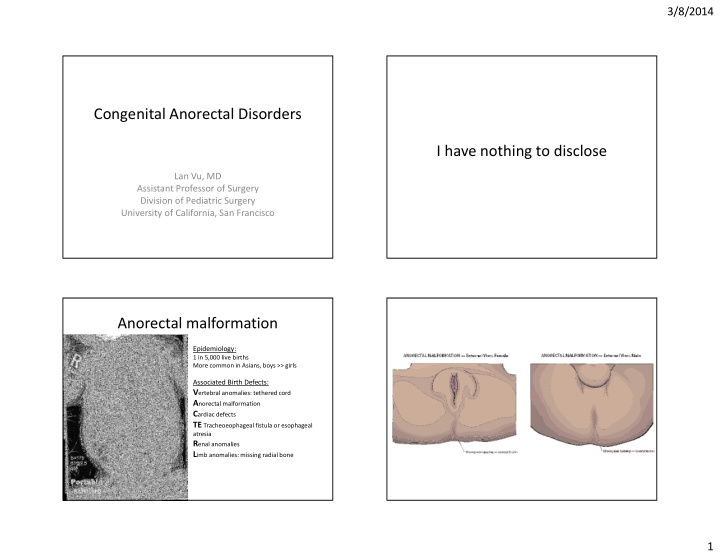



3/8/2014 Congenital Anorectal Disorders I have nothing to disclose Lan Vu, MD Assistant Professor of Surgery Division of Pediatric Surgery University of California, San Francisco Anorectal malformation Epidemiology: 1 in 5,000 live births More common in Asians, boys >> girls Associated Birth Defects: V ertebral anomalies: tethered cord A norectal malformation C ardiac defects TE Tracheoeophageal fistula or esophageal atresia R enal anomalies L imb anomalies: missing radial bone 1
3/8/2014 Rectum connects to vaginal opening Key points for colostomy: 1. At the level of descending colon: allow for enough length for future pull-through procedure 2. Double barrel stomas: prevent stool spillage into the blind-ending rectum or into urinary fistula 2
3/8/2014 Posterior Sagittal Anorectoplasty (PSARP), Laparoscopic assisted anorectal pull-through Alberto Pena (1980) (LAARP), K Georgeson (2000) Fecal Incontinence Refocus: • Definition: “repetitive (voluntary or involuntary) passage of stool in inappropriate From changing surgical techniques to defining places by children four years of age and older, markers of clinical postoperative outcomes at which time a child may be reasonably and improving postoperative management expected to have completed toilet training and to exercise bowel control” 3
3/8/2014 Postoperative function and Diagnostic studies to evaluate Quality of Life anatomy and function • Poor for high ARM, good for low ARM • QOL correlates with fecal continence • Distinguishing “pseudoincontinence” from • 34 ARM patients (fecal incontinence) constipation from “true incontinence” - feasibility study to evaluate pelvic anatomy - no correlation with clinical management • Limitations: - Need MRI standards for normal pelvic anatomy - Justification of cost Long-term function Australia, 2007: series of 167 patients with ARM from 1982 to 2000 • (only 84 patients responded to questionnaires) - Soiling problems in 86%, 79%, and 43% (high, intermediate, and low malformation) - Constipation 62%, abdominal pain 49% - Behavioral problems 80% (15% suicidal ideation) Pena et al, 2000: series of 1192 patients over 19 years • • 17 ARM patients - only 38% totally continent - IAS disruption and pressure > 20 mm Hg � - 25% suffered fecal incontinence - bowel management program to improve quality of life (95% biofeedback and laxatives success) - absence of IAS and pressure < 20 mm Hg � 1. Daily enemas to clean patients with constipation 2. Constipating diet or medication for those with fecal incontinence daily enemas Continence dependent on level of malformation • Stooling problems continue into adolescence • Limitations: feasibility of study at young age • Importance of follow-up and bowel management program • 4
3/8/2014 Take-home points • VACTERL association • Colostomy needs to leave adequate distal • 175 patients with ARM (4-17 years) length for future pull-through procedure • 12%: did not know level of anomaly • Long-term quality of life correlates with fecal • 33% had bowel management program continence - started at mean age of 3.5 yrs) • Early education and initiation of bowel - 50% improved QOL management program: distinguishing - 35% small improvements pseuodo-incontinence from true incontinence. - 10% no improvement 5
Recommend
More recommend